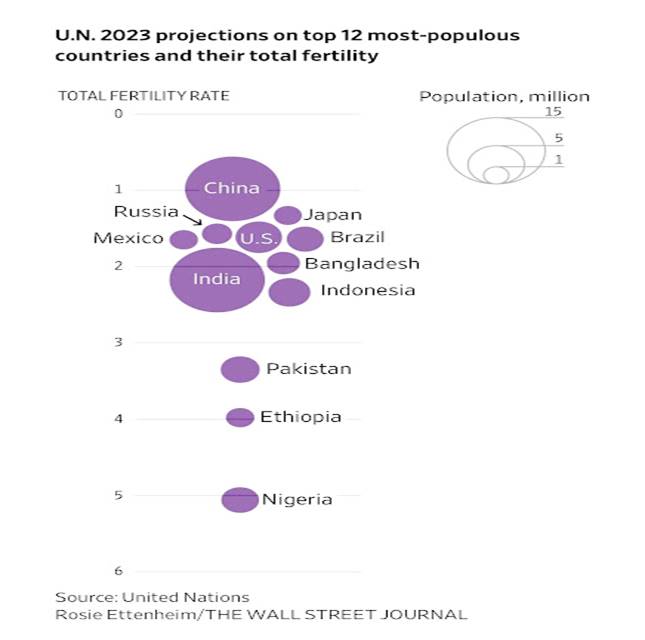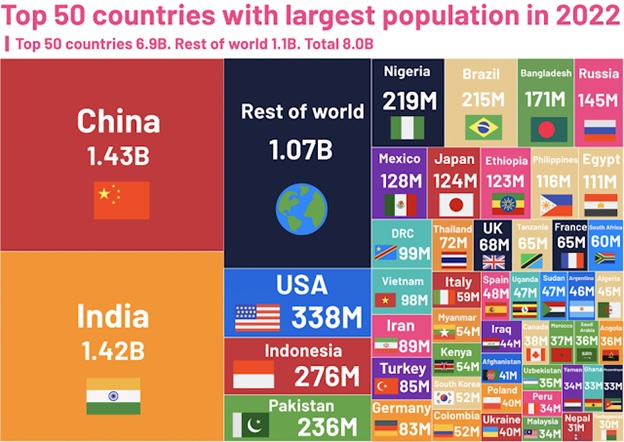
Daily Mail
Global Baby Bust: Pakistan Is a Rare Bright Spot among Most Populous Nations in Asia
By Riaz Haq
CA

There is an alarming rapid decline in fertility rates in both developed and developing nations, according to the United Nations. Here is how the Wall Street Journa l describes the trend: "The world is at a startling demographic milestone. Sometime soon, the global fertility rate will drop below the point needed to keep the population constant. It may have already happened".

|
Total Fertility Rates in 12 most populous nations - Wall Street Journal |
Birth rates are low and fertility is rapidly dropping for women across all levels of income, education and labor-force participation around the world. Fertility is falling among Pakistani women too but more slowly than elsewhere in Asia. In fact, Pakistani women have the third highest fertility rate (3.47) among the 12 most populous nations of the world. |
Birth rates have economic, social and geopolitical consequences. "The falling birthrates come with huge implications for the way people live, how economies grow and the standings of the world’s superpowers", says the Wall Street Journal report titled "Suddenly There Aren’t Enough Babies. The Whole World Is Alarmed".
No challenge is greater than the irreversible decline in female fertility rates that China, Japan, South Korea and the West are now experiencing. It's an existential threat. Nations and civilizations with sub-replacement fertility rates will eventually cease to exist. Automation cannot replace young curious minds responsible for new ideas, innovation, and social and economic vitality. Nor can automation replace consumers needed to buy and pay for products and services produced by robots.
Back in 2022, Goldman Sachs analysts Kevin Daly and Tadas Gedminas projected Pakistan's economy to grow to become the world's sixth largest by 2075. In a research paper titled " The Path to 2075 ", the authors predicted Pakistan's GDP to rise to $12.7 trillion with per capita income of $27,100. India’s GDP in 2075 is projected at $52.5 trillion and per capita GDP at $31,300. Bangladesh is projected to be a $6.3 trillion economy with per capita income of $31,000. By 2075, China will be the top global economy, followed by India, US 3rd, Indonesia 4th, Nigeria 5th and Pakistan 6th. The forecast is based primarily on changes in the size of working age populations over the next 50 years.
Economic Impact of Slower Population Growth
Daly and Gedminas argue that slowing population growth in the developed world is causing their economic growth to decelerate. At the same time, the economies of the developing countries are driven by their rising populations. Here are four key points made in the report:
1) Slower global potential growth, led by weaker population growth.
2) EM convergence remains intact, led by Asia’s powerhouses. Although real GDP growth has slowed in both developed and emerging economies, in relative terms EM growth continues to outstrip DM growth.
3) A decade of US exceptionalism that is unlikely to be repeated.
4) Less global inequality, more local inequality. |
|
Demographic Dividend
With rapidly aging populations and declining number of working age people in North America, Europe and East Asia, the demand for workers will increasingly be met by major labor exporting nations like Bangladesh, China, India, Mexico, Pakistan, Russia and Vietnam. Among these nations, Pakistan is the only major labor exporting country where the working age population is still rising faster than the birth rate.

|
World Population 2022 - Visual Capitalis t |

|
World Population 2050 - Visual Capitalist |
Over 10 million Pakistanis are currently working/living overseas, according to the Bureau of Emigration. Before the COVID-19 pandemic hit in 2020, more than 600,000 Pakistanis left the country to work overseas in 2019. Nearly 700,000 Pakistanis have already migrated in this calendar year. The average yearly outflow of Pakistani workers to OECD countries (mainly UK and US) and the Middle East was over half a million in the last decade.
World's 7th Largest Consumer Market
Pakistan's share of the working-age population (15-64 years) is growing as the country's birth rate declines, a phenomenon called demographic dividend . With the rising population of this working age group, Pakistan is projected by the World Economic Forum to become the world's 7th largest consumer market by 2030. Nearly 60 million Pakistanis will join the consumer class (consumers spending more than $11 per day) to raise the country's consumer market ranks from 15 to 7 by 2030. WEF forecasts the world's top 10 consumer markets of 2030 to be as follows: China, India, the United States, Indonesia, Russia, Brazil, Pakistan, Japan, Egypt and Mexico. Global investors chasing bigger returns will almost certainly shift more of their attention and money to the biggest movers among the top 10 consumer markets, including Pakistan. Already, the year 2021 has been a banner year for investments in Pakistani technology startups .
Record Remittances From Overseas Pakistanis:
Pakistan is already seeing high levels of labor export and record remittances of over $30 billion pouring into the country. Saudi Arabia and the United Arab Emirates (UAE) are the top two sources of remittances but the biggest increase (58%) in remittances is seen this year from Pakistanis in the next two sources: the United Kingdom and the United States.
Remittances from the European Union (EU) to Pakistan soared 49.7% in FY 21 and 28.3% in FY22, according to the State Bank of Pakistan. With $2.5 billion remittances in the first 9 months (July-March) of the current fiscal year, the EU ($2.5 billion) has now surpassed North America ($2.2 billion) to become the third largest source of inflows to Pakistan after the Middle East and the United Kingdom. Remittances from the US have grown 21%, the second fastest after the EU (28.3%) in the first 9 months of the current fiscal year.
Pakistan ranks 6th among the top worker remittance recipient countries in the world. India and China rank first and second, followed by Mexico 3rd, the Philippines 4th, Egypt 5 th, and Pakistan 6th.
About two million Pakistanis are entering the workforce every year. The share of the working age population in Pakistan is increasing while the birth rate is declining. This phenomenon, known as demographic dividend , is coinciding with declines in working age populations in developed countries. It is creating an opportunity for over half a million Pakistani workers to migrate and work overseas, and send home record remittances.
(Riaz Haq is a Silicon Valley-based Pakistani-American analyst and writer. He blogs at www.riazhaq.com )

